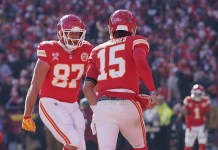Sports wagering has become more mainstream in the U.S. with Nevada leading the way in creative offerings and marketing. Race and Sports Books are the excitement centers at resorts throughout the state and are now available literally in the palms of peoples’ hands with the advent of mobile apps. VSiN, the first platform solely dedicated to this unique business, brings the entertainment and insight immediately to viewers (online at VSiN.com) and listeners (SiriusXM 204) on a daily basis. The following is a chronological journey through the years.
KEY EVENTS IN THE HISTORY OF RACE & SPORTS BETTING IN NEVADA
1931 – Gambling (including Race & Sports wagering) was legalized in Nevada. Bet slips were hand written.
Mid-1940s – Benjamin Siegelbaum, commonly referred to as “Bugsy Siegel," was technically the first race disseminator in the state. One of the features of this service was race information (entries, odds, results) – otherwise known as the "Race Wire’." Today the Race Information Service, or "Wire Service," is operated by Las Vegas Dissemination Company which is owned by John Gaughan. Note: The other currently licensed disseminator in Nevada is Roberts Communications owned by Todd Roberts.
1940s-50s – The Wire Service evolved into the Swanson News Service with Race results posted off of the UPI Wire Ticker, utilizing information from The Daily Racing Form. Horse races were re-created over a P.A. system 15 minutes after races were official. Race re-creations were a standard feature through the 1980s. Sports results were posted off of the UPI & Western Union Tickers.
1950 – The Kefauver Commission held a one-day hearing in Las Vegas on Nov. 15.
1951 – In May, the Nevada legislature mandated that licensees could no longer lay off wagers with out-of-state bookmakers.
1955 – The Nevada Legislature created the Nevada Gaming Control Board.
1950s, 60s & 70s – The handle on Race & Sports remained consistently nominal, mainly because the federal tax on these wagers was 10%.
1960 – An old law preventing wagering on elections was reinstated by the Nevada legislature.
1969 – Bill Dark began posting totals (Overs/Unders) on baseball games at his Del Mar Race & Sports Book in North Las Vegas.
1969 – The Nevada Gaming Control Board began to keep track of race & sports handle. The state runs on a fiscal year from July through June. At the time, there were a dozen licensed Race & Sports Books in the state. The total race handle was $2,113,600 while sports handle totaled $395,750.
1974 – Nevada Senator Howard Cannon led the way to have the federal tax on Race & Sports wagers reduced from 10% to 2%.
1975 – At the time, Race & Sports Books were limited to a few stand-alone, privately owned operations. The Union Plaza, located on Fremont Street in Downtown Las Vegas was owned by Jackie Gaughan. He opened a Race & Sports Book and hired two nationally respected odds- makers/bookmakers to run the operation – Bob Martin & Johnny Quinn. They showed select live televised ball games and added a local TV show once a week.
1976 – The Stardust, which was run by Frank “Lefty” Rosenthal opened the first Race & Sports Book in a Strip casino and promoted it heavily. He began a weekly television show which aired live from the Stardust in 1977.
1977 – The Castaways Hotel & Casino added the "Hole-in-the-Wall" Sports Book which became the second bookmaking operation in a Strip property. It was run by Julius “Sonny” Reizner who offered sports bets only – no horse racing.
1979 – In March, Michael Gaughan along with several partners including Frank Toti, Kenny Epstein and Tito Tiberti opened the Barbary Coast Hotel & Casino on the corner of the Strip & Flamingo. The property included a Race & Sports Book, which was the third in a Strip property. Jack ‘Pittsburgh Jack’ Franzi was the property’s odds maker. VSiN personalities Jimmy Vaccaro was the Sports Book Manager, Chris Andrews was a ticket writer and Vinny Magliulo dealt dice and “studied” in the Race & Sports Book. The success and popularity of this Book accelerated the other major Strip resorts – most notably Caesars Palace, MGM Grand (now Bally’s) and the Dunes to add a Race & Sports Book to their operations.
1979 – Jackie Gaughan took bets on where the Skylab space station would crash in 1979, including offering odds of 10,000-to-1 it would land on his El Cortez Hotel & Casino. These Skylab odds are considered to be the first proposition bets in our industry and gained national & international attention.
1980 – Live horse races from Arlington Park were shown at the Union Plaza. Caesars Palace, which brought major boxing events to Las Vegas for several years, hosted the Muhammad Ali- Larry Holmes Heavyweight Title bout in a temporary 16,000 seat arena constructed adjacent to the tennis courts and pool area. Future bouts included a satellite wagering area on one of the tennis courts next to the arena.
1980-81 – Castaways Sports Book Director Sonny Reizner posted odds on ‘Who Shot JR?” the fictional lead character on the television show ‘Dallas’. Like the Skylab ‘props’ two years earlier, the media loved it.
1982 – Caesars Palace televised live horse races from Bowie Race Track in Maryland. Additionally, an important gaming enterprise was founded and launched this year: Michael ‘Roxy’ Roxborough created Las Vegas Sports Consultants. LVSC was recognized and licensed by the Nevada Gaming Control Board to provide odds and credible information to Nevada’s licensed operators.
1983 – Caesars Palace began televising live races from the New York Racing Association and the era of simulcasting was introduced in Nevada. Additionally, the federal tax on race & sports wagers was again reduced from 2% to .25%. Licensees were also approved to operate more than one Book thus creating today’s ‘networks’ whereby multiple Books could be managed from a centralized location.
1985 – Frank Scott of Sports Media, Inc. provided live horse racing signals from California. Given the proximity to Nevada, the interest/betting handle was higher than other race offerings.
1986 – The Gaming Control Board mandated that all bet tickets & wagering reports were to be computer generated. Given the cost of this changeover, licensees were given two years to comply.
1991 – The Nevada Pari-Mutuel Association was approved by Nevada regulators. Participating Race Books could provide their patrons with the ability to wager directly into the pools at race tracks throughout North America. Up to then, all race wagers were “booked” in the same manner as sports bets with house limits imposed on payouts. For the first time patrons in Nevada could bet into all race pools offered by tracks, including the popular Pick-6 with lucrative payouts.
Mid-1990s – The first in-game offerings were established at the Excalibur & Bally’s hotel/casinos. Former Race & Sports Book operator Sid Diamond spearheaded the project.
2010 – Nevada’s total race handle for 2010 was $383,000,000 while sports generated a handle of $2,759,000,000.
2016 – Veteran operator Vic Salerno succeeded in securing the state’s first Fantasy Sports approval from state regulators and founded US Fantasy, which is currently offered on a pari- mutuel basis. Race Handle: $292,363,000. Sports Handle: $4.5 Billion.
2017 – In April, for the first time, Nevada Sports Books were able to offer odds & accept wagers on the NFL Draft. Offerings on the NBA Draft followed in June. Nevada handle on key sports events in 2017: Super Bowl Nevada Handle: $138,480,000. March Madness: $300,650,000 Kentucky Derby: $5,600,000 Final Four: $14,100,000.
Thanks to Michael Roxborough and Arne K. Lang for their assistance with fact checking/event verification. Both men are respected members of our industry. They are also accomplished authors. Roxy’s text on Race & Sports Book Management is a solid guideline for operators. Arne has written several books, including Sports Betting and Bookmaking: An American History.





